In the past few years, femtosecond lasers
have become the “bladeless scalpel” of choice for ophthalmic surgeons.
By nature, femtosecond lasers produce extremely brief, high-energy light pulses
that can sear targeted tissue so quickly and accurately that the lasers’ heat
has no time to escape and damage nearby healthy cells.
 Femtosecond lasers make it possible to cut material very precisely
at the micron scale, which is making waves in the treatment of common vision problems
including near- and farsightedness, astigmatisms and, in the future, even cataracts.
Femtosecond lasers make it possible to cut material very precisely
at the micron scale, which is making waves in the treatment of common vision problems
including near- and farsightedness, astigmatisms and, in the future, even cataracts.
At Ultralase Ltd., the UK’s longest-established vision correction
specialist, eye surgeons have been so impressed with results of femtosecond laser-based
surgery that the company now performs all laser-assisted in situ keratomileusis
(lasik) procedures using the technology.
Lasik corrects vision by creating a thin flap on the eye, which
is then folded back to allow laser remodeling of the tissue beneath.
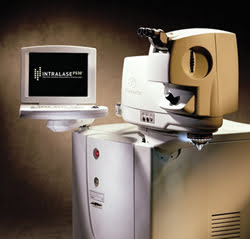
The Intralase femtosecond laser used by Ultralase. Courtesy of Abbott
Medical Optics Inc.
“The flap of corneal tissue created as part of a lasik procedure
was previously created by mechanical means, using an instrument called a microkeratome,”
said Graham Cox, an optometrist and the professional services manager at Ultralase.
“The femtosecond laser allows much greater precision, which has meant faster
recovery times for patients, improved visual results and greater safety.”
In fact, the incidence of complications from this procedure fell
from 1 in 300 to 1 in 3000 since Ultralase began using the femtosecond “scalpel.”
These improvements were so marked that the company made the decision three years
ago to offer solely femtosecond laser treatments to its patients, so that all 31
of its clinics were equipped with the new technology at the same time.
Intralase is the femtosecond laser system employed by Ultralase
to create the flap in the corneal tissue. This technology was acquired by Abbott
Medical Optics (AMO) Inc., a health care company based in Santa Ana, Calif., that
provides a host of advanced refractive technologies.
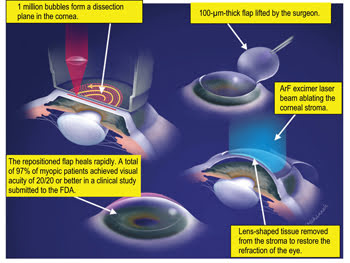
Images depicting the IntraLase method developed at Abbott Medical Optics Inc. for creation of a corneal
flap during the lasik procedure. Courtesy of Abbott Medical Optics Inc.
Zsolt Bor, principal scientist at AMO, said that one of the crucial
advantages of the Intralase method is that damage to surrounding tissue can be minimized.
“The thermal diffusion length in the femtosecond or subpicosecond range is
only a few nanometers. Therefore, the collateral thermal damage zone is very small
– less than the size of a cell. Another advantage of such laser surgery is
that tissue breakdown can be obtained with submicrojoule laser pulses; thus, the
total laser energy delivered into the treated eye structure is minimal.”
The laser currently produced at AMO is a solid-state design that
leverages diode pumping and chirped pulsed amplification. For ophthalmology purposes,
the optimum repetition rate appears to be between 100 and 200 kHz at microjoule
energy levels.
But it is not just in preparing the eye for correction where femtosecond
lasers are improving results. Scientists are taking the next step and using these
lasers to ablate the eye beneath.
Femtosecond lasers can be used in combination with a high-numerical-aperture
objective to create a spatially confined point of damage. The highly localized deposition
of energy generates a micro-plasma in the focal area in a process known as dielectric
breakdown, or “photodisruption.”
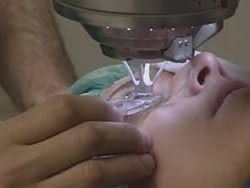
Femtosecond laser in use by a surgeon.
Unfortunately, unwanted secondary effects also occur in the form
of shock waves and cavitation bubbles. Although the secondary effects caused by
longer laser pulses propagate up to several millimeters before dissipating into
acoustic waves, these are dissipated within a few microns following femtosecond
pulses.
At Harvard University in Cambridge, Mass., internationally recognized
scientist and researcher Eric Mazur heads up a research group that explores both
the fundamental interest and technological relevance of femtosecond pulses. He believes
that femtosecond lasers may prove to be the most advanced surgical method in ophthalmology
in the 21st century.
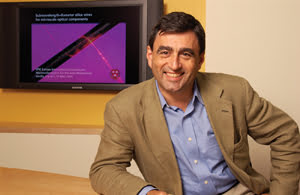
Eric Mazur believes that femtosecond lasers may prove to be the most advanced surgical
method in ophthalmology in the 21st century. Courtesy of Stu Rosner.
“Conventional methods to correct myopia (shortsightedness),
hyperopia (farsightedness) and astigmatism traditionally employ ultraviolet excimer
lasers for direct photoablation at the corneal surface,” Mazur said. “Unlike
local photodisruption initiated by ultrafast lasers, dielectric breakdown at longer
pulse durations (ns) uses a much higher energy per pulse that can lead to larger
secondary effects and more damage to surrounding tissue. These uncontrolled side
effects can result in surgical mistakes or pain for patients.”
Femtosecond lasers combat astigmatisms and cataracts
Another treatment that now employs femtosecond technology is corneal
relaxing incisions. These are carried out on patients with high degrees of astigmatism.
“These incisions were previously made with a surgical diamond
blade, and the advent of advanced femtosecond technology has allowed much greater
precision, predictability and quality of results,” Ultralase’s Cox said.
Femtosecond lasers are expected to have the same implications
on safety, predictability and complication rates in the field of cataract surgery
as they have already demonstrated in the domain of laser refractive surgery.
Cataract surgery is the most frequently performed procedure in
the US, with more than 1.5 million done each year, according to an age-related eye
disease study carried out by the National Eye Institute in 2010. It is estimated
that about one-third of Americans will undergo cataract surgery in their lifetime.
Daniel V. Palanker, an associate professor at Stanford University
in California, and his colleagues recently devised a faster, cleaner way to remove
cataracts – clouding of the lens in the eye – by marrying the cutting
precision of a femtosecond laser with optical coherence tomography. He said the
findings could change the way doctors perform cataract surgery.
In their study, which was published Nov. 17, 2010, in the AAAS
journal Science Translational Medicine, the researchers used OCT to map the lens
of the eye, identifying the boundaries of the cataract-afflicted lens. Then they
used a femtosecond laser to make a circular cut in the lens capsule above the cloudy
lens and to cut the lens into small enough pieces for removal. They also used the
laser to make the final cuts on the surface of the cornea.
Incredibly, because the laser cuts do not completely pierce the
cornea, the procedure can be performed outside of the operating room.
The team tested the method in pig and human eyes from an eye bank
before moving onto human patients. Palanker and colleagues found that the laser
surgery was 10 times more precise in human eyes than with the conventional manual
procedure.
Femtosecond lasers also are found at work in the dentist’s
chair for bone and tissue cutting. Although mechanical methods may lead to a broadening
of the cut and, thus, increase the chance of bacterial contamination, infrared lasers
cause a noninvasive ablation in the focal area.
What’s more, when compared with traditional Er:YAG (microsecond)
lasers that can induce thermal stress on the bones, leading to cracks, femtosecond
lasers can ablate dental tissue without these unwanted side effects.
More applications
The variety of femtosecond laser systems is large, including diode-pumped,
fiber and mode-locked diode. As each has different advantages and drawbacks, the
choice of one system ultimately depends on a trade-off of power, repetition rate
and pulse duration versus laser setup cost.
One of the most commonly used ultrashort pulsed solid-state lasers
is the Ti:sapphire, in which a transition-metal-doped gain medium emits from 650
to 1100 nm. Its repetition rate can be as high as several gigahertz and as low as
a few hertz, with 80 MHz being a typical value for most purposes. Its pulse durations
also are tunable, with a minimum pulse duration of ~5 to 10 fs.
When applied at a high repetition rate, even the ultrashort-pulse
laser may lead to an accumulation of deposited energy. This accumulation effect
may be beneficial for micromachining and nanowaveguide writing and for the development
of other photonic devices.
“Due to their ultrashort pulses and localized energy deposition,
femtosecond lasers function as precise cutting tools for a variety of nanoscale
applications,” Harvard’s Mazur said. “For instance, the development
of micromachining in the past decade has revolutionized the waveguide and material
processing industry. While conventional lithographic techniques are restricted to
the doping of two-dimensional surfaces, micromachining allows for precise three-dimensional
changes in materials.”
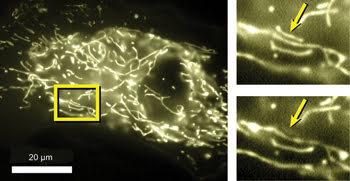
This picture demonstrates the accuracy of femtosecond ablation with
the elimination of a single mitochondrion inside a cell. Courtesy of Mazur Group,
Harvard University.
Some of the most recent results include complex embedded waveguide
systems and glass nanofibers. Considering the increased attention that laser-mediated
systems have gained among biologists, the next big breakthrough in ultrafast optics
may well be under way.
The prospect of noninvasive, highly efficient manipulation techniques
at a subcellular level appeal both to the biological and medical communities, and
physical tools in these areas are in high demand. Scientists believe that they may
provide effective means to help us understand and cure severe diseases such as cancer.
However, Mazur points out, cost remains a dampening factor.
“Even though research advances with ultrafast lasers at
the interface of biology and medicine take place rapidly,” he said, “all
‘breakthrough’ technologies need time before they reach the market,
a process that may even be prolonged with ultrafast technologies due to the high
cost of femtosecond laser setups, as can be seen in the case of corneal refractive
surgery.”